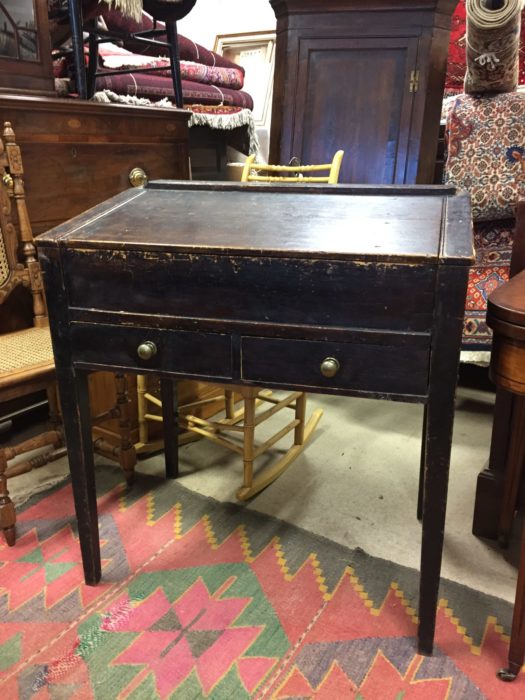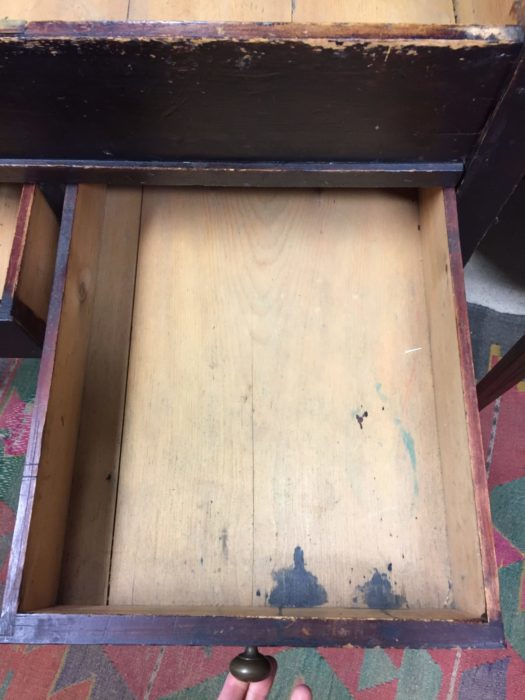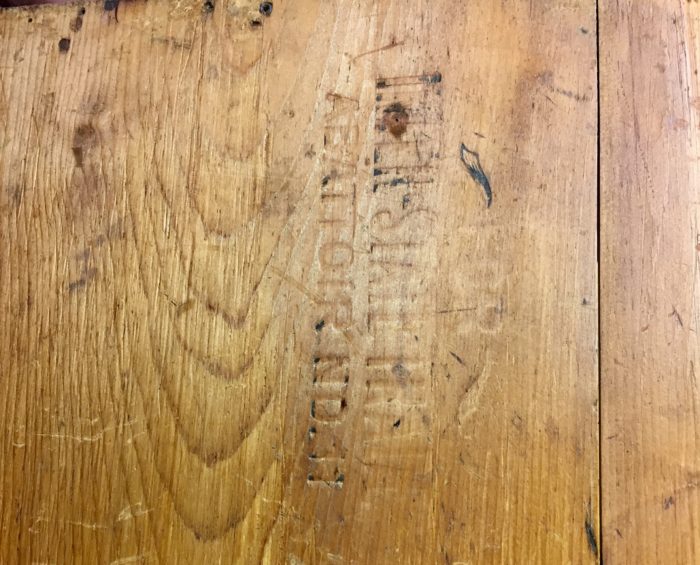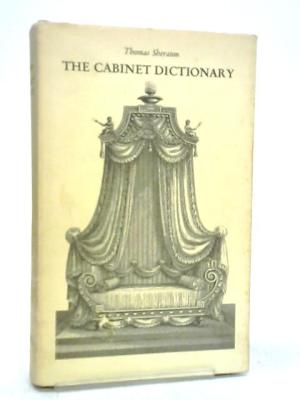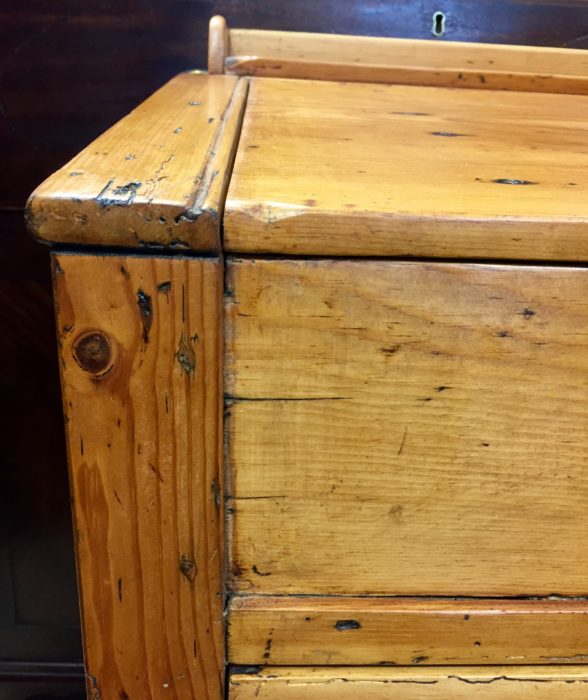Scottish Country Furniture Enthusiast
Once in a while you have the pleasure to come across a true enthusiast. Someone who, whether or not you’ve previously had any interest in or knowledge of a subject, can inspire you to enthusiasm and even fascination. Giles Pearson is that sort of a man.
When I dropped into his workshop at Logie Steading a couple of weeks ago a good half-hour flew by unnoticed while Giles leapt up pulling out drawers, removing a clock front to show the hand painted face and demonstrating with mime the workings of a Victorian wood-lathe, all the while regaling me with tales of each piece of furniture and his suspected back-story for it. Admittedly, I was egging him on (don’t worry, you can walk in for a browse or a quote without this level of discussion, but if you have the time, it’s well worth the experience), and I couldn’t stop as each piece of furniture seemed to tell a tale more unusual than the last.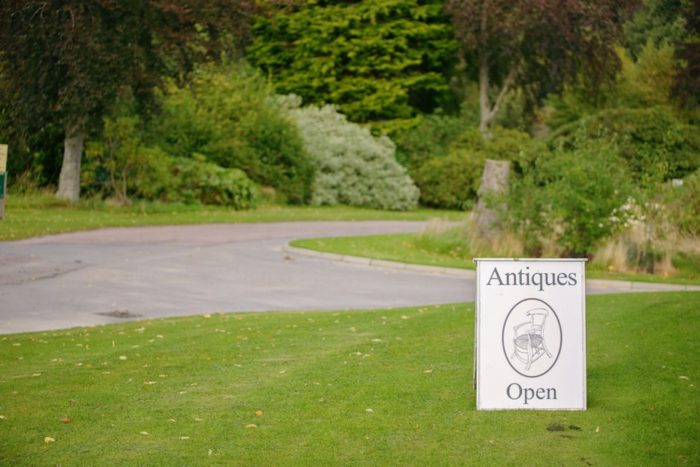
The Story and Restoration of a C19th Desk
It’s a desk that I’m going to focus on today and the reason it’s taken me a couple of weeks to post this is that I wanted to show you the desk before, during and after Giles’ restoration.
I’m not going to be able to hint at the infectious enthusiasm with which Giles described his interpretation of the history of this piece, so I’ll stick to the facts as I remember them. He started by telling me a bit about the look of the desk, it’s square tapering leg in the Georgian style and its construction, for example the internal drawer planks which go front to back not side to side, also suggesting that it’s a Georgian-era piece. Giles explained that in later Victorian drawers, the planks tend to run side to side as with a wider board you might just need one piece of wood to base line a drawer.
Detecting the History of the Desk
At this point I was starting to enjoy the detective work. Giles had been intrigued by the desk and picked it up at a local mart, and assumes it to be a highland piece, made for a teacher’s desk, quite possibly from the west coast. He believes it to be a teacher’s desk because he says that the primitive cubby holes do not look like proper letter boxes but were perhaps for notes and the like and the whole affair is quite rudimentary so probably wasn’t commissioned by someone to have in their grand highland house.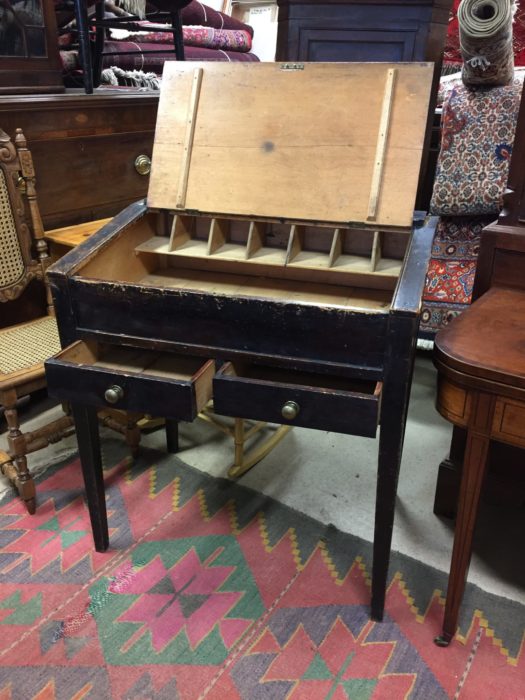
The fact that there is a little ink on desk makes him suspect that it is probably not a child’s desk but a teacher’s because ink was scarce and most children (and often teachers) would have written in pencil.
How Do We Know the Desk Was Made in the Highlands?
Or – why do we believe it to be so. Here’s where more of the social history and Giles’ personal theory comes in. He was quick to emphasise that he doesn’t know that this is the true history of the desk, but that experience, knowledge and enthusiasm lead him to believe that this could well be its back-story.
Before the railway came to the region from 1860, travel to the highlands was by boat or horse. In these circumstances a heavy and precious piece of furniture would have been very difficult to get here. This is one of the reasons that in the highlands usually only the types of wood locally available were used, hence furniture was often stained or scumbled (a paint effect) to simulate the more contemporarily desirable oak (like this pine desk). One of the North American pine base planks of the drawers has an imprinted inscription, ‘Interstate Trade, Abattoir no 11’ so possibly this piece of wood was repurposed from a packing case that had travelled from overseas. That was the piece of wood available to the furniture-maker and so that is what he (as it almost undoubtedly would have been a he) has used.
Each estate had its own trades-people living and working there. But these people didn’t generally travel to the urban centres and they had to work out how to replicate the things the family of the grand house had seen on their winter travels to Edinburgh or more local centres. From 1803 they had the Sheraton Cabinet Dictionary to use, but other than that it was just these descriptions.
As such highland furniture was often more rudimentary than that found in the major centres where the master cabinet makers generally trained and worked. For example, in this desk, there is no tongue and groove and no dovetailed joints, the pieces of wood are sometimes nailed onto each other square in quite a rudimentary fashion (inside the drawers), and sometimes double-tennoned and then pegged (no glue) which creates a very sturdy construction for such a dainty desk. You can see here the line where they cut the tendons and how beautifully, and sturdily it is put together:
The Restoration of the Highland Teacher’s Desk
Giles started work on the desk both to restore its original features and to bring it in line with contemporary expectations of how plain country furniture should look. I.e. we no longer feel that wood needs to be stained darker to represent oak, and we like to be able to see the inherent properties of a wood like antique pine. So here’s the desk having been stripped back and the upstand around the back returned. The original brass drawer-knobs are tucked inside the drawer for safe-keeping.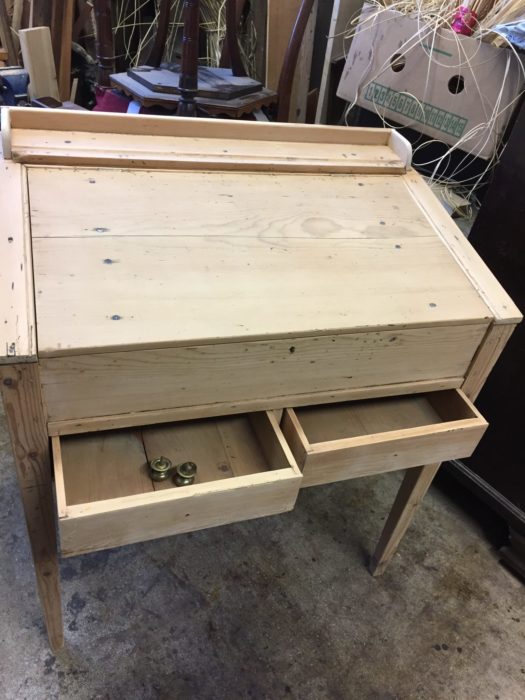
And here’s the finished article: repaired, stripped, waxed and lightly sealed to protect it. I wonder if the teachers who may have used it would recognise it now. I can just imagine a stern look over the top of that lid. All it needs now is a new home to love it. I’m quite tempted. I wonder if it’s been snapped up already..
Disclaimer! While Giles believes this to be a close approximation of the origins and history of this desk, he does not say absolutely that it is so, it is his own personal theory. While there are still ‘experts’ debating over the authenticity of multi-million dollar paintings, often with far more documented histories, I don’t think it would be reasonable to expect him to commit absolutely. So there you have it, what we believe to be a highland teacher’s desk, and nonetheless a very pretty piece.
Giles Pearson
If you’d like a taster of Giles, why not watch this clip made a couple of years ago for a series called ‘The Keepers’. Or, even better, come down to Logie Steading and see him and the ever-changing pieces of furniture vying for attention in his workroom. Almost every one has a story..
Update April 2022:
Giles has now retired from full-time shop life but still restores furniture from his home nearby. If you’d like to contact him about a project his details are:
Telephone: 07842 599367
gilespearsonantiques@gmail.com

